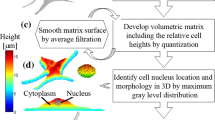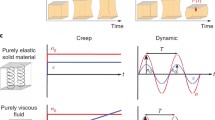Abstract
Emerging evidence indicates that cellular mechanical behavior can be altered by disease, drug treatment, and mechanical loading. To effectively investigate how disease and mechanical or biochemical treatments influence cellular mechanical behavior, it is imperative to determine the source of large inter-cell differences in whole-cell mechanical behavior within a single cell line. In this study, we used the atomic force microscope to investigate the effects of cell morphological parameters and confluency on whole-cell mechanical behavior for osteoblastic and fibroblastic cells. For nonconfluent cells, projected nucleus area, cell area, and cell aspect ratio were not correlated with mechanical behavior (p ≥ 0.46), as characterized by a parallel-spring recruitment model. However, measured force-deformation responses were statistically different between osteoblastic and fibroblastic cells (p < 0.001) and between confluent and nonconfluent cells (p < 0.001). Osteoblastic cells were 2.3–2.8 times stiffer than fibroblastic cells, and confluent cells were 1.5–1.8 times stiffer than nonconfluent cells. The results indicate that structural differences related to phenotype and confluency affect whole-cell mechanical behavior, while structural differences related to global morphology do not. This suggests that cytoskeleton structural parameters, such as filament density, filament crosslinking, and cell–cell and cell–matrix attachments, dominate inter-cell variability in whole-cell mechanical behavior.





Similar content being viewed by others
REFERENCES
A-Hassan, E., W. F. Heinz, M. D. Antonik, N. P. D’Costa, S. Nageswaran, C. Schoenenberger, and J. H. Hoh. Relative microelastic mapping of living cells by atomic force microscopy. Biophys. J. 74:1564–1578, 1998.
Butt, H. J., and M. Jaschke. Calculation of thermal noise in atomic force microscopy. Nanotechnology 6:1–7, 1995.
Charras, G. T., and M. A. Horton. Single cell mechanotransduction and its modulation analyzed by atomic force microscope indentation. Biophys. J. 82:2970–2981, 2002.
Charras, G. T., P. P. Lehenkari, and M. A. Horton. Atomic force microscopy can be used to mechanically stimulate osteoblasts and evaluate cellular strain distributions. Ultramicroscopy 86:85–95, 2001.
Chen, C. S., J. L. Alonso, E. Ostuni, G. M. Whitesides, and D. E. Ingber. Cell shape provides global control of focal adhesion assembly. Biochem. Biophys. Res. Commun. 307:355–361, 2003.
Chen, N. X., D. J. Geist, D. C. Genetos, F. M. Pavalko, and R. L. Duncan. Fluid shear-induced NFkappaB translocation in osteoblasts is mediated by intracellular calcium release. Bone 33:399–410, 2003.
Collinsworth, A. M., S. Zhang, W. E. Kraus, and G. A. Truskey. Apparent elastic modulus and hysteresis of skeletal muscle cells throughout differentiation. Am. J. Physiol. Cell Physiol. 283:C1219–C1227, 2002.
Costa, K. D. Single-cell elastography: Probing for disease with the atomic force microscope. Dis. Markers 19:139–154, 2004.
Coughlin, M. F., and D. Stamenovic. A prestressed cable network model of the adherent cell cytoskeleton. Biophys. J. 84:1328–1336, 2003.
Freshney, R. I. Culture of Animal Cells. New York: Wiley-Liss, 2000.
Galbraith, C. G., R. Skalak, and S. Chien. Shear stress induces spatial reorganization of the endothelial cell cytoskeleton. Cell Motil. Cytoskeleton 40:317–330, 1998.
Glogauer, M., P. Arora, G. Yao, I. Sokholov, J. Ferrier, and C. A. McCulloch. Calcium ions and tyrosine phosphorylation interact coordinately with actin to regulate cytoprotective responses to stretching. J. Cell Sci. 110:11–21, 1997.
Goldmann, W. H., R. Galneder, M. Ludwig, W. Xu, E. D. Adamson, N. Wang, and R. M. Ezzell. Differences in elasticity of vinculin-deficient F9 cells measured by magnetometry and atomic force microscopy. Exp. Cell Res. 239:235–242, 1998.
Grubbs, F. E. Procedures for detecting outlying observations in samples. Technometrics 11:1–21, 1969.
Hale, J. E., J. E. Chin, Y. Ishikawa, P. R. Paradiso, and R. E. Wuthier. Correlation between distribution of cytoskeletal proteins and release of alkaline phosphatase-rich vesicles by epiphyseal chondrocytes in primary culture. Cell Motil. 3:501–512, 1983.
Hutter, J. L., and J. Bechhoefer. Calibration of atomic-force microscope tips. Rev. Sci. Instrum. 64:1868–1873, 1993.
Jaasma, M. J., W. M. Jackson, and T. M. Keaveny. Measurement and characterization of whole-cell mechanical behavior. Ann. Biomed. Eng., DOI: 10.1007/s10439-006-9081-0.
Janmey, P. A. The cytoskeleton and cell signaling: Component localization and mechanical coupling. Physiol. Rev. 78:763–781, 1998.
Jones, W. R., H. P. Ting-Beall, G. M. Lee, S. S. Kelly, R. Hochmuth, and F. Guilak. Alterations in the Young's modulus and volumetric properties of chondrocytes isolated from normal and osteoarthritic human cartilage. J. Biomech. 32:119–127, 1999.
Ko, K. S., and C. A. McCulloch. Partners in protection: Interdependence of cytoskeleton and plasma membrane in adaptations to applied forces. J. Membr. Biol. 174:85–95, 2000.
Lampugnani, M. G., M. Corada, P. Andriopoulou, S. Esser, W. Risau, and E. Dejana. Cell confluence regulates tyrosine phosphorylation of adherens junction components in endothelial cells. J. Cell Sci. 110:2065–2077, 1997.
Lekka, M., P. Laidler, D. Gil, J. Lekki, Z. Stachura, and A. Z. Hrynkiewicz. Elasticity of normal and cancerous human bladder cells studied by scanning force microscopy. Eur. Biophys. J. 28:312–316, 1999.
Luegmayr, E., H. Glantschnig, F. Varga, and K. Klaushofer. The organization of adherens junctions in mouse osteoblast-like cells (MC3T3-E1) and their modulation by triiodothyronine and 1,25-dihydroxyvitamin D3. Histochem. Cell Biol. 113:467–478, 2000.
Mahaffy, R. E., C. K. Shih, F. C. MacKintosh, and J. Kas. Scanning probe-based frequency-dependent microrheology of polymer gels and biological cells. Phys. Rev. Lett. 85:880–883, 2000.
Malek, A. M., and S. Izumo. Mechanism of endothelial cell shape change and cytoskeletal remodeling in response to fluid shear stress. J. Cell Sci. 109 (Pt 4):713–726, 1996.
Maniotis, A. J., C. S. Chen, and D. E. Ingber. Demonstration of mechanical connections between integrins, cytoskeletal filaments, and nucleoplasm that stabilize nuclear structure. Proc. Natl. Acad. Sci. U.S.A. 94:849–854, 1997.
Mathur, A. B., A. M. Collinsworth, W. M. Reichert, W. E. Kraus, and G. A. Truskey. Endothelial, cardiac muscle and skeletal muscle exhibit different viscous and elastic properties as determined by atomic force microscopy. J. Biomech. 34:1545–1553, 2001.
McGarry, J., J. Klein-Nulend, and P. J. Prendergast. The effect of cytoskeletal disruption on pulsatile fluid flow-induced nitric oxide and prostaglandin E(2) in osteocytes and osteoblasts. Biochem. Biophys. Res. Commun. 330:341–348, 2005.
Nagayama, M., H. Haga, and K. Kawabata. Drastic change of local stiffness distribution correlating to cell migration in living fibroblasts. Cell Motil. Cytoskeleton 50:173–179, 2001.
Pasternak, C., S. Wong, and E. L. Elson. Mechanical function of dystrophin in muscle cells. J. Cell Biol. 128:355–361, 1995.
Radmacher, M., M. Fritz, C. M. Kacher, J. P. Cleveland, and P. K. Hansma. Measuring the viscoelastic properties of human platelets with the atomic force microscope. Biophys. J. 70:556–567, 1996.
Rotsch, C., and M. Radmacher. Drug-induced changes in cytoskeletal structure and mechanics in fibroblasts: An atomic force microscopy study. Biophys. J. 78:520–535, 2000.
Sato, M., M. J. Levesque, and R. M. Nerem. Micropipette aspiration of cultured bovine aortic endothelial cells exposed to shear stress. Arteriosclerosis 7:276–286, 1987.
Sato, M., K. Nagayama, N. Kataoka, M. Sasaki, and K. Hane. Local mechanical properties measured by atomic force microscopy for cultured bovine endothelial cells exposed to shear stress. J. Biomech. 33:127–135, 2000.
Sato, M., D. P. Theret, L. T. Wheeler, N. Ohshima, and R. Nerem. Application of the micropipette technique to the measurement of cultured porcine aortic endothelial cell viscoelastic properties. J. Biomech. Eng. 112:263–268, 1990.
Smith, P. G., L. Deng, J. J. Fredberg, and G. N. Maksym. Mechanical strain increases cell stiffness through cytoskeletal filament reorganization. Am. J. Physiol. Lung Cell. Mol. Physiol. 285:L456–L463, 2003.
Sokal, R. R., and F. J. Rohlf. Biometry. New York: W. H. Freeman, 1995.
Stamenovic, D., and M. F. Coughlin. The role of prestress and architecture of the cytoskeleton and deformability of cytoskeletal filaments in mechanics of adherent cells: A quantitative analysis. J. Theor. Biol. 201:63–74, 1999.
Stamenovic, D., and D. E. Ingber. Models of cytoskeletal mechanics of adherent cells. Biomech. Model. Mechanobiol. 1:95–108, 2002.
Sugawara, M., Y. Ishida, and H. Wada. Mechanical properties of sensory and supporting cells in the organ of Corti of the guinea pig cochlea—study by atomic force microscopy. Hear. Res. 192:57–64, 2004.
Wu, H. W., T. Kuhn, and V. T. Moy. Mechanical properties of L929 cells measured by atomic force microscopy: Effects of anticytoskeletal drugs and membrane crosslinking. Scanning 20:389–397, 1998.
Wu, Z. Z., G. Zhang, M. Long, H. B. Wang, G. B. Song, and S. X. Cai. Comparison of the viscoelastic properties of normal hepatocytes and hepatocellular carcinoma cells under cytoskeletal perturbation. Biorheology 37:279–290, 2000.
Xu, F., and Z. J. Zhao. Cell density regulates tyrosine phosphorylation and localization of focal adhesion kinase. Exp. Cell Res. 262:49–58, 2001.
Zar, J. H. Biostatistical Analysis. Englewood Cliffs, NJ: Prentice-Hall, 1984.
ACKNOWLEDGMENTS
Funding for this study was provided by the National Science Foundation (BES-0201951) and the Whitaker Foundation Graduate Fellowship Program (WMJ). The authors would like to thank May Chu and Raymond Tang for technical assistance. The authors would also like to thank Terry D. Johnson for the generous gift of the NIH3T3 fibroblasts.
Author information
Authors and Affiliations
Corresponding author
Rights and permissions
About this article
Cite this article
Jaasma, M.J., Jackson, W.M. & Keaveny, T.M. The Effects of Morphology, Confluency, and Phenotype on Whole-Cell Mechanical Behavior. Ann Biomed Eng 34, 759–768 (2006). https://doi.org/10.1007/s10439-005-9052-x
Received:
Accepted:
Published:
Issue Date:
DOI: https://doi.org/10.1007/s10439-005-9052-x




